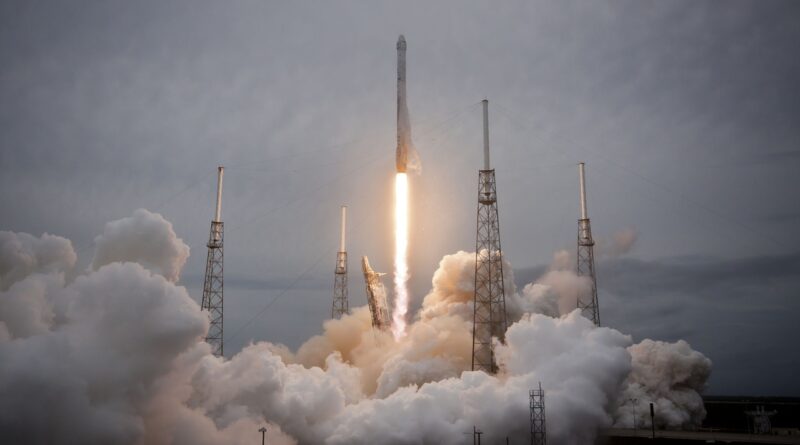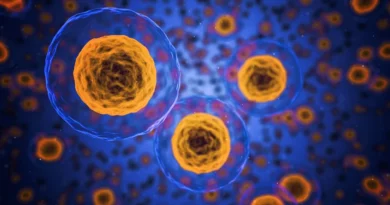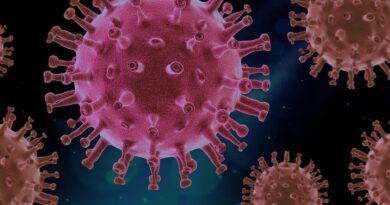SpaceX lunch
A SpaceX Falcon 9 rocket carrying two veteran NASA astronauts lifted off on Saturday on an historic first private crewed flight into space. The two-stage Falcon 9 rocket with astronauts Robert Behnken and Douglas Hurley aboard blasted off smoothly in a cloud of orange flames and smoke from Launch Pad 39A at Florida’s Kennedy Space Center for the 19-hour voyage to the International Space Station. The first booster stage of the rocket separated cleanly and landed upright on a barge off the Atlantic coast. The second stage also separated smoothly, sending the astronauts in the Crew Dragon capsule on their way to the space station orbiting some 250 miles (450 kilometers) above the Earth. The first crewed flight from US soil since the space shuttle program ended in 2011 had originally been scheduled for Wednesday but was delayed because of weather conditions, which also remained uncertain on Saturday right up until liftoff at 3:22 pm (1922 GMT). President Donald Trump flew to Florida aboard Air Force One to watch the launch and described it as “really something special.””Real talent, real genius, nobody does it like us,” Trump said. pre launch report SpaceX’s historic first crewed mission was set to blast off for the International Space Station at 3:22pm ET on Saturday, NASA said, although uncertainty remained over weather conditions at the Florida launch site. “We are moving forward with launch today,” NASA chief Jim Bridenstine said in a tweet. “Weather challenges remain with a 50 percent chance of cancellation.” “Proceeding with countdown today,” said SpaceX founder Elon Musk, the entrepreneur whose California-based company is seeking to become the first private firm to send astronauts into space. Weather forced the postponement on Wednesday of what would have been the first launch of American astronauts from US soil since the space shuttle program ended in 2011. The Falcon 9 rocket with SpaceX’s Crew Dragon capsule is scheduled to liftoff at 3:22 pm Eastern Time (1922 GMT) on what is designed to be the final test flight before NASA certifies the spacecraft for regular crew flights. The next window, which is determined by the relative position of the launch site to the space station, is Sunday at 3:00 pm (1900 GMT), and fair weather is predicted. NASA astronauts Robert Behnken, 49, and Douglas Hurley, 53, former military test pilots who joined the US space agency in 2000, are to blast off for the ISS from historic Launch Pad 39A on a two-stage SpaceX Falcon 9 rocket. The same launch pad was used by Neil Armstrong and his Apollo 11 crewmates on their historic 1969 journey to the Moon, as NASA seeks to revive excitement around human space exploration ahead of a planned return to Earth’s satellite and then Mars. The mission comes despite nationwide shutdowns caused by the coronavirus pandemic. Behnken and Hurley, veterans of two space shuttle missions each, have been in quarantine for more than two weeks and have been regularly tested for COVID-19. NASA has urged crowds to stay away from Cocoa Beach, the traditional viewing spot — but that did not deter scores of space fans on Wednesday. President Donald Trump, who flew in for the previous launch attempt, is expected to attend again. – Defining moment for SpaceX – NASA has had to pay Russia for use of its Soyuz rockets to take US astronauts to space ever since the space shuttle program ended and the decision was taken to shift focus to commercial partners for missions in low Earth orbit. The Crew Dragon mission, dubbed “Demo-2,” is a defining moment for SpaceX, the company founded by Musk in 2002 with the goal of producing a lower-cost alternative to human spaceflight. SpaceX conducted a successful test flight of Crew Dragon to the ISS in March 2019 with a sensor-laden mannequin on board named Ripley, after the character played by Sigourney Weaver in the “Alien” movies. By 2012, it had become the first private company to dock a cargo capsule at the ISS, resupplying the station regularly ever since. Two years later, NASA ordered the next step: to transport its astronauts there by adapting the Dragon capsule. The US space agency paid more than $3 billion for SpaceX to design, build, test and operate its reusable capsule for six future space round-trips. The project has experienced delays, explosions, and parachute problems — but even so, SpaceX has beaten its competitor, aerospace giant Boeing, to the punch. Crew Dragon is scheduled to dock with the ISS about 19 hours after liftoff, for a duration that is yet to be finalized, but likely around early August. Wednesday’s flight was scrubbed 17 minutes before blastoff because of high levels of atmospheric electricity that could have triggered a lightning strike on the rocket. With astronauts Behnken and Hurley strapped into the Crew Dragon capsule, the launch pad platform retracted and rocket fueling underway, SpaceX and NASA made the call to abort. A live video feed showed Behnken and Hurley — in their futuristic white uniforms adorned with the US flag and the logos of NASA and SpaceX — waiting as propellant was unloaded from the reusable Falcon 9 rocket after the launch was postponed. What you need to know about SpaceX’s ‘Demo-2’ mission Kennedy Space Center, United States (AFP) May 30, 2020 – SpaceX’s “Demo-2” mission from NASA’s Kennedy Space Center in Florida this weekend will be the first flight with astronauts aboard the Crew Dragon capsule built by entrepreneur Elon Musk’s commercial space company. SpaceX conducted a successful test flight of Crew Dragon to the International Space Station (ISS) in March 2019 with a sensor-laden mannequin on board named Ripley, after the character played by Sigourney Weaver in the “Alien” movies. Bob Behnken, 49, and Douglas Hurley, 53, former military test pilots who joined NASA in 2000, are to blast off from historic Launch Pad 39A on a two-stage SpaceX Falcon 9 rocket. NASA has tentatively scheduled the launch for Saturday afternoon but will assess the weather situation that morning and may decide to push the flight back to Sunday or even a later date. Wednesday’s scheduled flight was scrubbed 17 minutes before blastoff because of weather concerns. It will be the first crewed launch from US soil of a US-made rocket since the space shuttle program ended in 2011 and the first ever by a private company. Crew Dragon is scheduled to dock with the ISS about 19 hours after liftoff if Saturday’s launch goes ahead. – Preparation – Behnken and Hurley, veterans of two space shuttle missions each, have been in quarantine for more than two weeks and have been regularly tested for COVID-19. On launch day, they are to be served a hearty breakfast and undergo final medical checks.About four hours before liftoff, the pair will don their futuristic SpaceX-designed spacesuits and say goodbye to their wives — both former astronauts — and children. The astronauts will then be driven to Launch Pad 39A, which was used for Apollo 11’s historic 1969 trip to the Moon, in a Model X electric car built by Tesla, one of Musk’s other companies. After the 20-minute drive, Behnken and Hurley will ride an elevator to the Crew Dragon capsule sitting atop the Falcon 9 rocket. The astronauts will be strapped into their seats by ground technicians and begin final preparations.About two hours before liftoff, the hatch will be closed on the capsule and the astronauts will arm the escape system to be used in the event of an emergency during launch. Fueling of the rocket with propellant begins 45 minutes before liftoff. – Liftoff – Weather permitting, blastoff is scheduled for 3:22 pm (1922 GMT) on Saturday. President Donald Trump flew to Florida for Wednesday’s launch and tweeted after it was scrubbed that he would return again for the next attempt. The usual thousands of invited guests for a rocket launch will be absent this time because of the coronavirus pandemic. Two minutes and 33 seconds after liftoff, Falcon 9’s reusable first stage booster will separate and began its return to Earth, where it is planned to land upright off the Florida coast on a barge baptized “Of Course I Still Love You. “Twelve minutes after liftoff the second stage of the rocket separates from Crew Dragon. – Docking – Once in orbit, the astronauts are to carry out a number of checks of Crew Dragon on what is designed to be the final test flight before NASA certifies the capsule for regular crew flights. During the next 19 hours, Crew Dragon will head for the ISS, which is orbiting at an average altitude of 250 miles (400 kilometers) above the Earth. Crew Dragon will then dock autonomously with the ISS and Behnken and Hurley will join US astronaut Chris Cassidy and Russian cosmonauts Anatoly Ivanishin and Ivan Vagner aboard the orbiting space station. – Return – The length of the stay of Behnken and Hurley aboard the ISS has not been determined yet but Crew Dragon can spend up to 114 days in space, or 16 weeks.NASA administrator Jim Bridenstine has said they may return to Earth in early August. After detaching from the ISS, Crew Dragon will begin its descent, splashing down in the Atlantic Ocean off the coast of Florida. It will be slowed down by four large parachutes, the same method used for the return of NASA’s Apollo capsules, although they landed in the Pacific. |
- Source:https://www.spacedaily.com/reports/SpaceX_rocket_lifts_off_on_historic_private_crewed_flight_999.html



